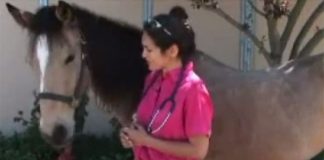Tendon and ligament injuries are common in horses. With an immense amount of body weight upheld by four spindly legs, it’s not a surprise that equines can develop issues with some of the structures housed inside this support system.
Diagnosis and Treatment
If your horse is lame with some localized swelling in one of his limbs, it’s time to call the vet. While he may have only rapped his leg on the fence or been the recipient of an ill-placed kick, lamenesses that are persistent and are accompanied by heat and swelling could be something much more serious.
Once your vet arrives, she will most likely do a general lameness exam, ruling out things like an abscess or other injury. “I typically then will ultrasound the area once other minor causes have been ruled out and if the area palpates abnormally. I ultrasound if I feel like it will give us the most information [versus an X-ray],” says Dr. Batten.

If the ultrasound indicates that there is an issue with a tendon, such as a tear in the tendon fibers, also called a bow, Dr. Batten will typically prescribe the following course of treatment:
- Cold hosing of the affected limb (or application of an ice boot) for at least 20 minutes, twice a day for the initial stage of the injury, which is a minimum of five days
- NSAID/Banamine use to help alleviate pain and inflammation
- Supportive bandaging to support the limb and minimize swelling as much as possible
While shoeing changes may be necessary, it ultimately depends on the type of injury and its severity, notes Dr. Batten. “Our goal at EMA is to get the foot as balanced as possible and to try not to change anything [like the hoof angles] too drastically.” Rapidly changing the angle or type of shoe could “put stress on other areas, causing different issues,” she explains. “The most important thing is to get the foot as balanced as possible, whether that means a good trimming job or a properly applied shoe.”
Supplements to Support
There are a lot of supplements on the market that claim to help support healthy tendons and ligaments, but do these really work?
“Many of the supplements provide the building blocks for healthy tendon healing and joint support,” explains Dr. Batten. “A lot of them have MSM and glucosamine, which are the building blocks for connective tissue, which provide the structural support for tendons and ligaments.”
Bottom line? They can’t hurt!

Back to Work
Dr. Batten works closely with the owner of an injured horse throughout the horse’s recuperation, encouraging videos and photos as a way to monitor a horse’s progress. After the initial ultrasound, Dr. Batten typically will set up another appointment within the next 30 to 90 to do a recheck scan (based on the severity of the injury). Rechecks are not hard-and-fast appointments, she notes, and vet visits are adjusted as needed.
While it can take between 8 months and a year for a horse to return to full work and strength after a tendon injury, Dr. Batten typically lets the horse return to a restricted exercise schedule after 1 month, which typically begins with handwalking and increases over time. As there is always a risk of reinjury, it’s important that the horse come back into work slowly. As the horse gets to the later stages of healing, Dr. Batten will re-ultrasound the injury site to ensure proper healing is taking place.
As the horse goes back into ridden work, Dr. Batten suggests that “any kind of wrap that provides tendon support” be used. “No tendon will gain back 100 percent of its elasticity and strength, and scar tissue is not as strong, so anything [an owner] can do to support the tendon will only benefit.”
It’s also very important to know the animal and the way it moves, Dr. Batten stresses. “Footing is very important, and any injury where the leg is destabilized side-to-side [such as tendon and ligament injuries] means proper footing becomes so much more important.”
When bringing a horse back to work, level, smooth footing is as important as what you are asking the horse to do. “Straight lines and large circles are better than longeing to minimize the stress and strain on tendons and ligaments.”
Ligament Injuries
Tending to a horse with a ligament issue is much the same as caring for a tendon problem, says Dr. Batten. However, one thing is strikingly different: Horses with ligament injuries tend to return to soundness much more quickly than those with tendon issues. In addition, horses with ligament issues “may not even show a lot of lameness,” Dr. Batten says. However, “there is still an injury there and it’s important not to get back to work too quickly.”
A tendon or ligament injury to your trusted steed is not always a career-ending prognosis. With prompt attention and dedicated care, there is a good chance your horse will go back to work with no residual effects.





